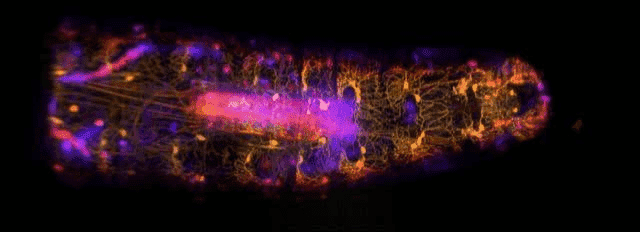Researchers have come up with a way to reduce the two-photon fluorescence microscope to a thumb size device that enables them to see inside the brain of live and active animals. The device is named Mini2P, and it only weighs 2.4 grams.
This breakthrough “opens the door to lines of scientific inquiry that were difficult, if not impossible, to initiate,” says Denise Cai, a neuroscientist at the Icahn School of Medicine at Mount Sinai in New York City.
Conventional fluorescence microscopy uses a single photon to excite fluorescent dyes; as the molecules ‘relax,’ they release light. This creates obstruction in thick tissues: as the light passes through the cellular layers, it is absorbed and scattered. The solution is here with the use of two-photon microscopes, which use two longer-wavelength photons that can transmit deeper into tissue.

This innovation is the result of the efforts of Edvard Moser, professor of Psychology and Neuroscience at the Kavli Institute for Systems Neuroscience, together with Weijing Zong, a biological engineer, and neuroscientist at the Moser Group.
There was a previous version of the device too that weighed 4.2 grams and had stiff optical fiber bundles. However, it slowed the mouse’s movement and interrupted its natural behavior.
The new design has three instrumental improvements.
It has a lighter case that is made from a plastic-like material instead of aluminum, a thinner and more flexible optical cable that does not hinder the mouse’s movement.
They used the static voltage, Zong, that could manipulate the curvature of the lens without raising the temperature. Changing the lens’s curvature will trigger Mini2P to shift the focal plane between the surface and deeper cell layers of the cortex, also allowing 3D structure recordings of brain tissue.
Scientists have tested Mini2P in several areas of the brain. This includes the navigation system, the memory hub, and the visual area. They used the patchwork quilt technique, like 10,000 brain cells across the visual cortex. All measurements were made while the mouse was doing its own thing without hindrance. This was not possible before this technology.
Mini2P is an open-source invention available from the Kavli Institute for Systems Neuroscience at NTNU in Trondheim.
The advancement can help researchers explore brain diseases such as Alzheimer’s in the future.
“We believe the Mini2P is a game changer, and we want to share it with neuroscientists and labs across the world,” says May-Britt Moser, a professor of Psychology and Neuroscience at the Norwegian University of Science and Technology
The blueprint, a shopping list, and instructional movies are available from GitHub. The Kavli Institute will also provide workshops to 16 researchers who will build their own Mini2P in December this year.
The study paper was published in the journal Cell.


